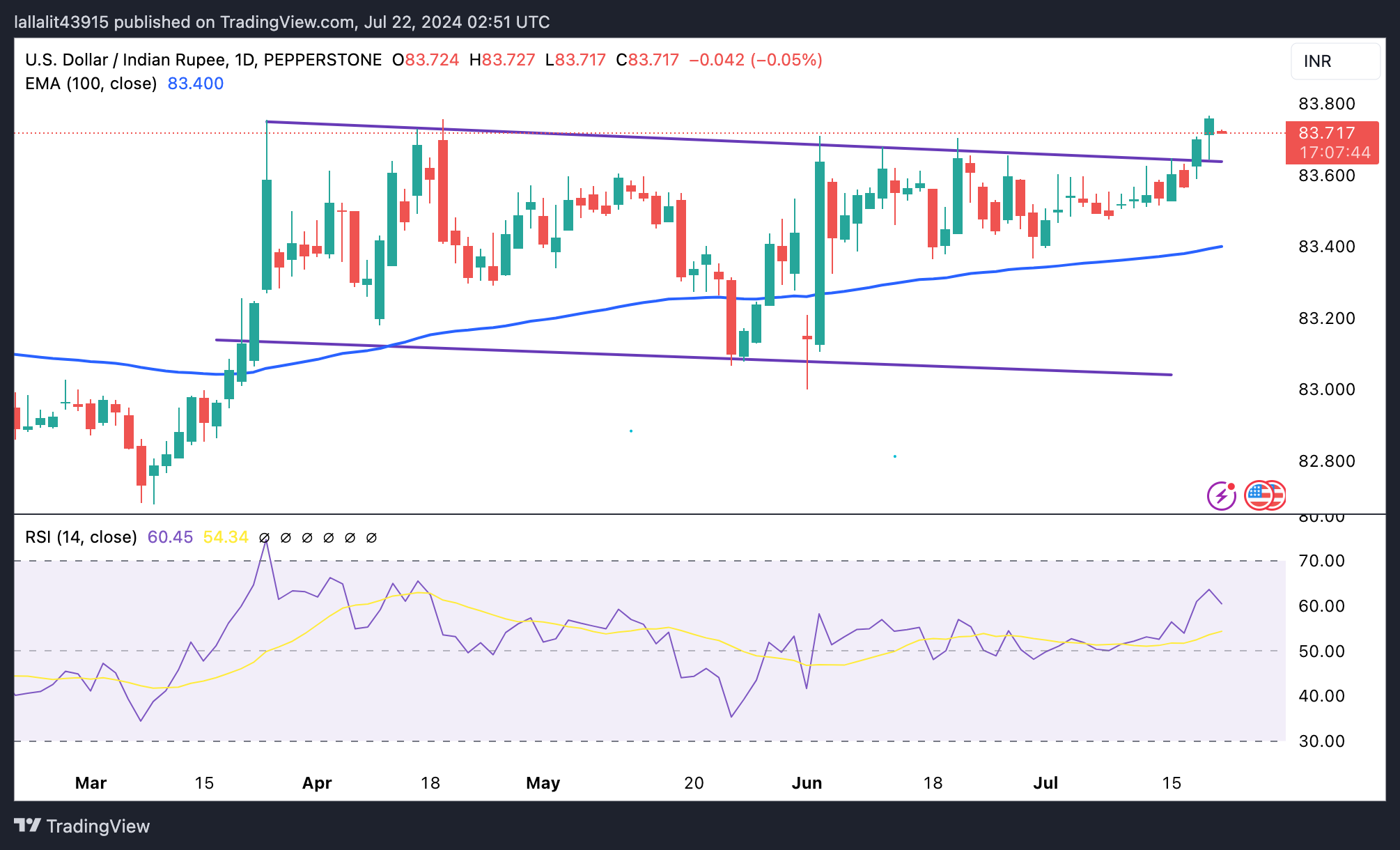- The Indian Rupee gains ground in Monday’s Asian session.
- Elevated oil prices might pressure the INR, while the renewed US Dollar demand might cap the local currency’s gains.
- Investors await the US Chicago Fed National Activity Index ahead of India’s Federal Budget on Tuesday.
The Indian Rupee (INR) trades on a stronger note on Monday amid the weaker US Dollar (USD). The rising speculations of a Federal Reserve (Fed) easing move in September have weighed on the Greenback in previous sessions. However, the high demand for USD, especially for defense and oil payments, might exert some selling pressure on the local currency. The downside for the INR might be limited amid the likely Reserve Bank of India (RBI) intervention to prevent a sharp depreciation in the Indian Rupee.
The US Chicago Fed National Activity Index for June is due on Monday. The highlights for this week will be the preliminary US S&P Global Purchasing Managers Index (PMI) for July, Gross Domestic Product (GDP) for the second quarter and the Personal Consumption Expenditures Price Index (PCE) data for June, which will be released on Wednesday, Thursday and Friday, respectively. On the Indian docket, traders will keep an eye on the Indian Union Budget on Tuesday.
Daily Digest Market Movers: Indian Rupee edges higher amid softer US Dollar
- The Indian Rupee closed at a record closing low of 83.6625 against the US Dollar on Friday, with likely intervention by the Reserve Bank of India (RBI) to stem losses. The currency was down 0.1% for the week, according to Reuters.
- India’s equity benchmark, BSE Sensex, fell 739 points, or 0.91%, to 80,605 on Friday. Meanwhile, the Nifty index closed at 24,531, down 270 points, or 1.1 % from its previous close.
- "We expect the Rupee to trade with a slight negative bias on weak global markets and a strength in the US Dollar. Weak Asian and European currencies may also weigh on the rupee," said Anuj Choudhary, Research Analyst at Sharekhan by BNP Paribas.
- New York Federal Reserve President John Williams said on Friday that an interest rate cut could be warranted in the coming months, but not at its July policy meeting, per WSJ.
- Financial markets are now pricing in the probability of a move at its July meeting less than 5% and pricing in nearly full rate cut is firmly expected in September, according to the CME FedWatch Tool.
Technical analysis: USD/INR keeps bullish vibe in the long term
The Indian Rupee trades firmer on the day. The uptrend has been in play for the USD/INR pair as it has confirmed a breakout above the month-long trading range while holding above the key 100-day Exponential Moving Average (EMA) on the daily chart. Furthermore, the upward momentum is also supported by the 14-day Relative Strength Index (RSI) points higher above 63.60, suggesting that further upside could be on the horizon.
The immediate resistance level for the pair will emerge at the all-time high of 83.77. The crucial hurdle is seen at the 84.00 psychological level.
On the downside, the resistance-turned-support level at 83.65 acts as an initial contention level. The additional downside filter to watch is 83.51 (low of July 12), followed by 83.40 (100-day EMA).
US Dollar price today
The table below shows the percentage change of US Dollar (USD) against listed major currencies today. US Dollar was the weakest against the Japanese Yen.
| USD | EUR | GBP | CAD | AUD | JPY | NZD | CHF | |
| USD | 0.14% | 0.11% | 0.22% | 0.47% | -0.68% | 0.36% | -0.08% | |
| EUR | -0.15% | -0.03% | 0.09% | 0.31% | -0.81% | 0.22% | -0.21% | |
| GBP | -0.11% | 0.01% | 0.10% | 0.35% | -0.82% | 0.25% | -0.21% | |
| CAD | -0.22% | -0.08% | -0.09% | 0.24% | -0.91% | 0.15% | -0.30% | |
| AUD | -0.48% | -0.32% | -0.35% | -0.23% | -1.17% | -0.08% | -0.55% | |
| JPY | 0.67% | 0.84% | 0.81% | 0.91% | 1.13% | 1.04% | 0.61% | |
| NZD | -0.36% | -0.25% | -0.25% | -0.14% | 0.10% | -1.05% | -0.48% | |
| CHF | 0.07% | 0.22% | 0.19% | 0.30% | 0.54% | -0.63% | 0.44% |
The heat map shows percentage changes of major currencies against each other. The base currency is picked from the left column, while the quote currency is picked from the top row. For example, if you pick the Euro from the left column and move along the horizontal line to the Japanese Yen, the percentage change displayed in the box will represent EUR (base)/JPY (quote).
Indian Rupee FAQs
The Indian Rupee (INR) is one of the most sensitive currencies to external factors. The price of Crude Oil (the country is highly dependent on imported Oil), the value of the US Dollar – most trade is conducted in USD – and the level of foreign investment, are all influential. Direct intervention by the Reserve Bank of India (RBI) in FX markets to keep the exchange rate stable, as well as the level of interest rates set by the RBI, are further major influencing factors on the Rupee.
The Reserve Bank of India (RBI) actively intervenes in forex markets to maintain a stable exchange rate, to help facilitate trade. In addition, the RBI tries to maintain the inflation rate at its 4% target by adjusting interest rates. Higher interest rates usually strengthen the Rupee. This is due to the role of the ‘carry trade’ in which investors borrow in countries with lower interest rates so as to place their money in countries’ offering relatively higher interest rates and profit from the difference.
Macroeconomic factors that influence the value of the Rupee include inflation, interest rates, the economic growth rate (GDP), the balance of trade, and inflows from foreign investment. A higher growth rate can lead to more overseas investment, pushing up demand for the Rupee. A less negative balance of trade will eventually lead to a stronger Rupee. Higher interest rates, especially real rates (interest rates less inflation) are also positive for the Rupee. A risk-on environment can lead to greater inflows of Foreign Direct and Indirect Investment (FDI and FII), which also benefit the Rupee.
Higher inflation, particularly, if it is comparatively higher than India’s peers, is generally negative for the currency as it reflects devaluation through oversupply. Inflation also increases the cost of exports, leading to more Rupees being sold to purchase foreign imports, which is Rupee-negative. At the same time, higher inflation usually leads to the Reserve Bank of India (RBI) raising interest rates and this can be positive for the Rupee, due to increased demand from international investors. The opposite effect is true of lower inflation.
Information on these pages contains forward-looking statements that involve risks and uncertainties. Markets and instruments profiled on this page are for informational purposes only and should not in any way come across as a recommendation to buy or sell in these assets. You should do your own thorough research before making any investment decisions. FXStreet does not in any way guarantee that this information is free from mistakes, errors, or material misstatements. It also does not guarantee that this information is of a timely nature. Investing in Open Markets involves a great deal of risk, including the loss of all or a portion of your investment, as well as emotional distress. All risks, losses and costs associated with investing, including total loss of principal, are your responsibility. The views and opinions expressed in this article are those of the authors and do not necessarily reflect the official policy or position of FXStreet nor its advertisers. The author will not be held responsible for information that is found at the end of links posted on this page.
If not otherwise explicitly mentioned in the body of the article, at the time of writing, the author has no position in any stock mentioned in this article and no business relationship with any company mentioned. The author has not received compensation for writing this article, other than from FXStreet.
FXStreet and the author do not provide personalized recommendations. The author makes no representations as to the accuracy, completeness, or suitability of this information. FXStreet and the author will not be liable for any errors, omissions or any losses, injuries or damages arising from this information and its display or use. Errors and omissions excepted.
The author and FXStreet are not registered investment advisors and nothing in this article is intended to be investment advice.
Recommended content
Editors’ Picks

EUR/USD turns lower to near 1.0800 ahead of German inflation data
EUR/USD has come under fresh selling and trades near 1.0800 in European trading on Monday. The pair feels the heat from a modest US Dollar comeback while Euro buyers stay cautious ahead of Germany's prelim inflation data and Trump's reciprocal tariff announcement.

Gold sits at record highs above $3,100 amid tariff woes
Gold price holds its record-setting rally toward $3,150 in European trading on Monday. The bullion continues to capitalize on safe-haven flows amid intesifying global tariff war fears. US economic concerns weigh on the US Dollar and Treasury yields, aiding the Gold price upsurge.

GBP/USD holds lower ground below 1.2950 amid tariff woes
GBP/USD has returned to negative territory in the European session on Monday. Concerns that US President Donald Trump's tariffs will ignite inflation and dampen economic growth have helped revive the havem demand for the US Dollar, weighing down on the pair.

Seven Fundamentals for the Week: “Liberation Day” tariffs and Nonfarm Payrolls to rock markets Premium
United States President Donald Trump is set to announce tariffs in the middle of the week; but reports, rumors, and counter-measures will likely dominate the headline. It is also a busy week on the economic data front, with a full buildup to the Nonfarm Payrolls (NFP) data for March.

US: Trump's 'Liberation day' – What to expect?
Trump has so far enacted tariff changes that have lifted the trade-weighted average tariff rate on all US imports by around 5.5-6.0%-points. While re-rerouting of trade will decrease the effectiveness of tariffs over time, the current level is already close to the highest since the second world war.

The Best brokers to trade EUR/USD
SPONSORED Discover the top brokers for trading EUR/USD in 2025. Our list features brokers with competitive spreads, fast execution, and powerful platforms. Whether you're a beginner or an expert, find the right partner to navigate the dynamic Forex market.


